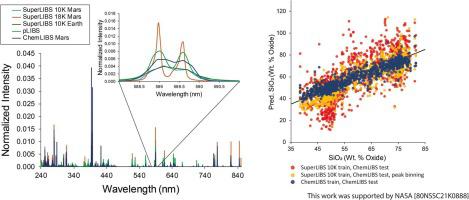Spectrochimica Acta Part B: Atomic Spectroscopy ( IF 3.3 ) Pub Date : 2023-12-15 , DOI: 10.1016/j.sab.2023.106839 K.H. Lepore , M.D. Dyar , C.R. Ytsma

|
The ability of a publicly accessible preexisting laser-induced breakdown spectroscopy (LIBS) database to train multivariate models to predict rock and mineral compositions from other laboratories or from remotely collected spectra is evaluated using LIBS spectra collected on >2500 unique geological targets using three different instruments and a range of collection protocols. Datasets collected under increasingly disparate conditions are utilized, including a single instrument with different resolution settings; two different instruments with very similar ablation and collection optics; and a benchtop instrument and portable instrument with different collection protocols, resolutions, and plasma conditions. Cross-calibration among datasets is performed for a range of scenarios designed to test the efficacy of post-processing techniques.
Major element predictions are most accurate when instrument parameters match among training and test spectra. Use of a piecewise direct standardization-partial least squares (PDS-PLS) calibration transfer algorithm reduces major element prediction uncertainties when the resolution of training and test spectra do not match. Even when training and test spectra are collected on different instruments, reasonable predictions can be derived by binning peak areas prior to training calibration models. Finally, incorporating a large, preexisting database into a smaller dataset collected under test conditions has the potential to greatly improve the reliability of predicted compositions. With careful consideration to match plasma conditions and utilize post-processing, existing large-scale LIBS calibration databases like the one used in this study can be used to boost LIBS accuracy and expand the potential of LIBS as a widely-applicable quantitative geochemical tool.
中文翻译:

使用谱线分级和校准传输在激光诱导击穿光谱仪器之间共享校准信息
使用三种不同仪器在超过 2500 个独特地质目标上收集的 LIBS 光谱,评估了可公开访问的现有激光诱导击穿光谱 (LIBS) 数据库训练多元模型以预测来自其他实验室或远程收集的光谱的岩石和矿物成分的能力以及一系列收集协议。利用在日益不同的条件下收集的数据集,包括具有不同分辨率设置的单个仪器;两种不同的仪器,具有非常相似的烧蚀和收集光学器件;以及具有不同收集协议、分辨率和等离子体条件的台式仪器和便携式仪器。针对一系列旨在测试后处理技术的功效的场景执行数据集之间的交叉校准。
当训练和测试光谱之间的仪器参数匹配时,主要元素预测是最准确的。当训练和测试光谱的分辨率不匹配时,使用分段直接标准化偏最小二乘 (PDS-PLS) 校准传递算法可减少主要元素预测的不确定性。即使在不同仪器上收集训练和测试光谱,也可以通过在训练校准模型之前对峰面积进行分箱来得出合理的预测。最后,将一个大型的、预先存在的数据库合并到在测试条件下收集的较小的数据集中有可能大大提高预测成分的可靠性。通过仔细考虑匹配等离子体条件并利用后处理,现有的大型 LIBS 校准数据库(如本研究中使用的数据库)可用于提高 LIBS 精度并扩展 LIBS 作为广泛应用的定量地球化学工具的潜力。



























 京公网安备 11010802027423号
京公网安备 11010802027423号